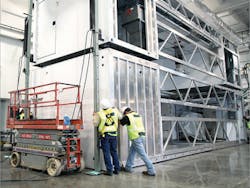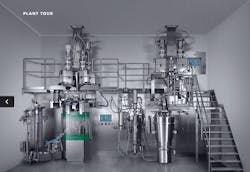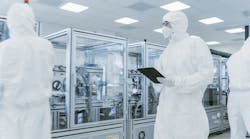Pfizer's Continuous Manufacturing Pod Comes in for a Landing
Whether creating capacity to ramp up production for a recently approved drug, adding more because a new dose form has skyrocketed demand, or creating a strategy to phase the replacement of aging global capacity, GEA Pharma Systems, G-CON Manufacturing and Pfizer have a new manufacturing vehicle they've been driving, a ride they'd like to share with the industry.
Awarded a 2015 INTERPHEX Exhibitor Award for Best Technology Innovation, the Portable, Continuous, Miniature and Modular (PCMM) is Pfizer's answer to the many issues associated with production capacity —from process efficiency to product quality. Recently the consortium's PCMM prefabricated processing modules were shipped to a building at Pfizer's Groton, Connecticut, R&D facility in a proof-of-concept installation that, by the end of March, was headed for commissioning and validation with operation slated for the end of 2015. In a nutshell, and the "nutshell" analogy fits, the PCMM integrates GEA continuous processing granulization and mixing equipment with smart control systems within a factory-fabricated G-CON POD (portable, self-contained GMP module) to process oral solid dose (OSD) forms.
Although pharma process-line engineering concepts like modularity, continuous manufacturing (CM) or pre-fabricated skid-mounted subsystems are relatively mature ideas, the PCMM integration breaks innovative ground, not so much for the combination of technologies, but in the scale of the continuous manufacturing process it deploys. Phil Nixon, of Pfizer's Pharmaceutical Sciences Technology & Innovation group in Groton, Connecticut, explains that the collaboration was intended to break new ground without breaking any.
"We've taken [the concept] further, he explains, "to make it something that can be readily deployed in a portable manner — we're trying to miniaturize it, make it more modular." Ultimately, says Nixon, who at INTERPHEX 2015 enthusiastically walked Pharmaceutical Manufacturing through the "factory," the aim is to achieve adaptability and flexibility. "By itself, continuous manufacturing gives us variable batch size," explains Nixon. "In today's world, a lot of products are [now produced in] smaller volume. We need to be able to change over faster, not only for emerging markets, but to be able to get new technology out there faster with new capabilities."
There's significant value in the concept and Pfizer's Nixon explains that it's going to drive the industry away from its "manufacture-to-forecast mentality," noting that "we have huge inventories that cost a lot a money. With [PCMM] we're going to more of a demand-driven approach. So market demand drives what we make, and therefore inventories will be pushed way down." By using the same exact equipment for development, clinical supplies and commercial supply, says Nixon, a lot less expensive API will be required.
Assembly of the megaPOD; top section, left, lifted and bottom section, left, being moved into place (Courtesy of G-CON Manufacturing Inc.)
According to Nixon the PCMM concept is a total risk killer, especially when considering the overall equipment and control and automation standardization: "The current way we do batches, you may use the same equipment when you go to a larger scale," says Nixon. "Usually, you're at least scaling up two times, often changing equipment in the process. Then you have different sites involved that [might not know] certain things about the equipment selected to bring things to scale. With the PCMM, it's the exact same equipment from beginning to end."When a new OSD processing line is likely to take three or more years to design and construct, the PCMM's 12-month design, build, start time frame is a game changer well-suited to meet the pressure being felt by all of Pharma to accelerate their time-to-market performance. Nixon described it this way: "About a month ago, we landed it in Groton at the R&D facility. And literally, in three days, we took these pieces of the POD and the equipment on the four plates and put it all together." Explaining that even with upcoming calibration and qualification, the units would soon be up and running and within about six/seven months: "It's on the ground; it's put together; and we're doing the work to get it up and running for GMP later this year."According to the collaborators, the PCMM concept was designed to address the rapidly changing requirements of pharmaceutical development and manufacturing, aiming to meet the industry's needs for continuous processing in a flexible, self-contained manufacturing space. Within the POD the process line has three major segments: Raw material dispensing, GEA's Consigma-25 twin screw wet granulization module and a continuous mixing and tablet compression platform. As far as miniaturization, Nixon says a PCMM offers a footprint some 60 to 70 percent less than a comparable "permanent" line.
POWDER TO TABLET IN 20 MINUTES
When GEA Pharma Systems introduced its ConsiGma continuous tableting line, it said the system was "In line with the FDA initiative of quality by design." In fact, GEA presented the system at the FDA's first, Continuous Manufacturing Symposium in 2010 as the only technology supplier ready to present a viable solution.
What has Pfizer and other GEA customers like Janssen Pharmaceutica and AstraZeneca find so appealing is the ability of the ConsiGma line to run as little as 500g in R&D, but also run clinical trial, launch size and any production-size batches. "There is no process scale-up," says GEA, "as time is the only relevant factor in a continuous process. This allows manufacturers to reduce development time dramatically to reduce costs and bring products to market much faster."
PCMM's integration of CM at a seemingly small scale is perhaps counterintuitive to current industry thinking, which posits that continuous manufacturing of solid dose forms is really only economically viable when it's accomplished at some amazing, giant scale. Nixon reiterates the concept of how scale becomes the subordinate driver of capacity because if one needs to produce more volume, one just runs the line longer to create it. "I chaired the Arden conference in Baltimore. And I think it was fascinating to see that almost every case study was for small-volume applications. I agree, that for decades in other industries, [CM was the choice] for really high-volume products. In this case, we're trying to say [PCMM is] suitable for both small and large volume runs." Nixon says the efficiency of the process is really key, so whether a Pharma company is making a small amount or a large amount, the process is set and validated from the very beginning of development and that the associated cost efficiencies of GEA's package are an affordable alternative that is infinitely scalable by adding more modules.
ConsiGma 25 continuous tableting line is a multipurpose manufacturing platform incorporating blending, wet granulation, drying and (direct) compression, as well as on-line quality monitoring. (Courtesy of GEA)
"We need options," says Nixon. "In this business, the near future is so uncertain. Things change so fast now that you have to have an option to deploy [manufacturing capacity quickly. It'll take us less than a year to deploy [PCMM] versus two or three years for a stick-built facility."Capable of doing particle design and mimicking any traditional batch granulation process, the granulation, drying and tablet compression lines are designed for "plug flow," which GEA explains is a first-in, first-out process, avoiding back mixing and allowing for control of critical quality attributes in-line.
Maik Jornitz, president of G-CON Manufacturing, said this in the INTERPHEX announcement: "We believe that these small footprint, efficient continuous systems will become the standard in the industry and that brick and mortar batch-based systems will become a thing of the past." While that remains to be seen, the concept has an intrinsic logic and the science is well established.
Richard Steiner, Business Development Manager at GEA Pharma Systems noted that the PCMM Consortium's visionary goals had been achieved through an advanced combination of technology and innovation. "What was introduced and described last year during Interphex 2014 hasn't just been delivered, it's also been proven to work," he said.
Summing it up, Nixon offers the Pfizer vision: "We are trying to get other pharmaceutical companies involved because we want this to be an industry standard. This isn't a proprietary Pfizer thing. We want everybody to use it."








